Invasion of Kuwait
The invasion of Kuwait on 2 August 1990 was a two-day operation conducted by Iraq against the neighboring State of Kuwait, which resulted in the seven-month-long Iraqi occupation of the country.[16] This invasion and Iraq's subsequent refusal to withdraw from Kuwait by a deadline mandated by the United Nations[17] led to military intervention by a United Nations-authorized coalition of forces led by the United States. These events came to be known as the first Gulf War and resulted in the expulsion of Iraqi forces from Kuwait and the Iraqis setting 600 Kuwaiti oil wells on fire during their retreat.
| Invasion of Kuwait | |||||||
|---|---|---|---|---|---|---|---|
| Part of the Gulf War and the Persian Gulf Conflicts | |||||||
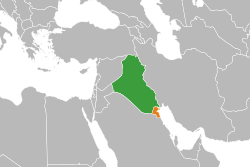 Iraq in green, Kuwait in orange | |||||||
| |||||||
| Belligerents | |||||||
|
|
| ||||||
| Commanders and leaders | |||||||
|
|
| ||||||
| Strength | |||||||
| 88,000[1][2][3] |
16,000[4] (Army) 2,200[4] (Air Force) 1,800[4] (Navy) | ||||||
| Casualties and losses | |||||||
|
295 killed 361 wounded 120 tanks & armoured vehicles destroyed[5] 39 aircraft destroyed 4 ships sunk |
420 killed 12,000 captured[6] about 250 tanks destroyed & captured 850+ armoured vehicles destroyed & captured[7][8][9][10] 57 aircraft destroyed[11] 8+ aircraft captured (Mirage F1s) 17 ships sunk 6 ships captured[12][13][14] 24 I-Hawk SAMs, 36 M-109 155mm, 20 AMX-F3 155mm SPHs[15] | ||||||
In early 1990 Iraq was accusing Kuwait of stealing Iraqi petroleum through slant drilling, although some Iraqi sources indicated Saddam Hussein's decision to attack Kuwait was made a few months before the actual invasion.[18] Some feel there were several reasons for the Iraqi move, including Iraq's inability to pay the more than US$14 billion that it had borrowed to finance the Iran–Iraq War, and Kuwaiti high petroleum production levels which kept revenues down for Iraq.[19] The invasion started on 2 August 1990, and within two days most of the Kuwait Armed Forces were either overrun by the Iraqi Republican Guard or fell back to neighbouring Saudi Arabia and Bahrain. Iraq set up a puppet government known as the "Republic of Kuwait" to rule over Kuwait and then annexed it outright, when Saddam Hussein announced a few days later that it was the 19th province of Iraq.
Dispute over the financial debt
When the Iran–Iraq War broke out, Kuwait initially stayed neutral and also tried mediating between Iran and Iraq. In 1982, Kuwait along with other Arab states of the Persian Gulf supported Iraq in order to curb the Iranian Revolutionary government. In 1982–1983, Kuwait began sending significant financial loans to Iraq. Kuwait's large-scale economic assistance to Iraq often triggered hostile Iranian actions against Kuwait. Iran repeatedly targeted Kuwaiti oil tankers in 1984 and fired weapons at Kuwaiti security personnel stationed on Bubiyan island in 1988.[20] During the Iran–Iraq War, Kuwait functioned as Iraq's major port once Basra was shut down by the fighting.[21] However, after the war ended, the friendly relations between the two neighbouring Arab countries turned sour for several economic and diplomatic reasons that culminated in an Iraqi invasion of Kuwait.
By the time the Iran–Iraq War ended, Iraq was not in a financial position to repay the 14 billion USD it borrowed from Kuwait to finance its war and requested that Kuwait forgive the debt.[19] Iraq argued that the war had prevented the rise of Iranian hegemony in Kuwait. However, Kuwait's reluctance to pardon the debt strained the relationship between the two countries. In late 1989, several official meetings were held between the Kuwaiti and Iraqi leaders, but they were unable to break the deadlock between the two.
Alleged economic warfare and slant drilling
In 1988 Iraq's Oil Minister, Issam al-Chalabi, stressed a further reduction in the crude oil production quota of Organization of the Petroleum Exporting Countries (OPEC) members so as to end the 1980s oil glut.[22] Chalabi argued that higher oil prices would help Iraq increase its revenues and pay back its US$60 billion debt.[22] However, given its large downstream petroleum industry, Kuwait was less concerned about the prices of crude oil and in 1989, Kuwait requested OPEC to increase the country's total oil production ceiling by 50% to 1.35 million barrels (215,000 m3) per day.[23] Throughout much of the 1980s, Kuwait's oil production was considerably above its mandatory OPEC quota and this had prevented a further increase in crude oil prices.[23] A lack of consensus among OPEC members undermined Iraq's efforts to end the oil glut and consequently prevented the recovery of its war-crippled economy.[24] According to former Iraqi Foreign Minister Tariq Aziz, "every US$1 drop in the price of a barrel of oil caused a US$1 billion drop in Iraq's annual revenues triggering an acute financial crisis in Baghdad".[21] Kuwait's refusal to decrease its oil production was viewed by Iraq as an act of aggression against it.
The increasingly tense relations between Iraq and Kuwait were further aggravated when Iraq alleged that Kuwait was slant-drilling across the border into Iraq's Rumaila field. The dispute over Rumaila field started in 1960 when an Arab League declaration marked the Iraq–Kuwait border 3 kilometres (2 mi) north of the southernmost tip of the Rumaila field.[25] During the Iran–Iraq War, Iraqi oil drilling operations in Rumaila declined while Kuwait's operations increased. In 1989, Iraq accused Kuwait of using "advanced drilling techniques" to exploit oil from its share of the Rumaila field. Iraq estimated that US$2.4 billion worth of Iraqi oil was "stolen" by Kuwait and demanded compensation.[26] Kuwait dismissed the accusations as a false Iraqi ploy to justify military action against it. Several foreign firms working in the Rumaila field also dismissed Iraq's slant-drilling claims as a "smokescreen to disguise Iraq's more ambitious intentions".[25]
On 25 July 1990, only a few days before the Iraqi invasion, OPEC officials said that Kuwait and the United Arab Emirates had agreed to a proposal to limit oil output to 1.5 million barrels (240,000 m3) per day, thus potentially settling differences over oil policy between Kuwait and Iraq.[27] At the time of the settlement, more than 100,000 Iraqi troops were deployed along the Iraq–Kuwait border, and American officials expressed little indication of decline in tensions despite the OPEC settlement.[28]
Iraqi hegemonic claims
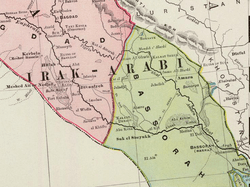
Many westerners believed that Iraq's invasion of Kuwait was largely motivated by its desire to take control over the latter's vast oil reserves. The Iraqi government justified its invasion by claiming that Kuwait was a natural part of Iraq carved off as a result of British imperialism. After signing the Anglo-Ottoman Convention of 1913, the United Kingdom planned to split Kuwait from the Ottoman territories into a separate sheikhdom, but this agreement was never ratified. The Iraqi government also argued that the Kuwaiti Emir was a highly unpopular figure among the Kuwaiti populace. By overthrowing the Emir, Iraq claimed that it granted Kuwaitis greater economic and political freedom.[19]
Kuwait had been loosely under the authority of the Ottoman vilâyet of Basra, and although its ruling dynasty, the Al Sabah family, had concluded a protectorate agreement in 1899 that assigned responsibility for its foreign affairs to Britain, it did not make any attempt to secede from the Ottoman Empire. For this reason, its borders with the rest of Basra province were never clearly defined or mutually agreed.
Iraqi–U.S. relations
On 25 July 1990, April Glaspie, the U.S. ambassador to Iraq, asked the Iraqi high command to explain the military preparations in progress, including the massing of Iraqi troops near the border.
The American ambassador declared to her Iraqi interlocutor that Washington, "inspired by the friendship and not by confrontation, does not have an opinion" on the disagreement between Kuwait and Iraq, stating "we have no opinion on the Arab–Arab conflicts".
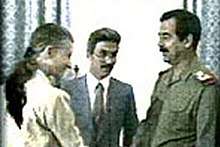
Glaspie also indicated to Saddam Hussein that the United States did not intend "to start an economic war against Iraq". These statements may have caused Saddam to believe he had received a diplomatic green light from the United States to invade Kuwait.[29][30] This exchange only became public knowledge in 2011, following a WikiLeaks release of a cable, sent by the US embassy in Iraq, following on from Ms Glaspie's meeting with Saddam Hussein. In addition, one week before the invasion, the Assistant Secretary of State, John Kelly, told the US congress that the US had no treaty obligations to defend Kuwait.
According to Richard E. Rubenstein, Glaspie was later asked by British journalists why she had said that, her response was "we didn't think he would go that far" meaning invade and annex the whole country. Although no follow-up question was asked, it can be inferred that what the U.S. government thought in July 1990 was that Saddam Hussein was only interested in pressuring Kuwait into debt forgiveness and to lower oil production.[31]
Invasion
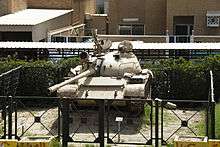
On 2 August 1990 at 2:00 am,[32] local time, by Saddam Hussein’s order Iraq launched an invasion of Kuwait with four elite Iraqi Republican Guard divisions (1st Hammurabi Armoured Division, 2nd al-Medinah al-Munawera Armoured Division, 3rd Tawakalna ala-Allah Mechanized Infantry Division and 4th Nebuchadnezzar Motorized Infantry Division) and Iraqi Army special forces units equivalent to a full division. The main thrust was conducted by the commandos deployed by helicopters and boats to attack Kuwait City (see Battle of Dasman Palace), while the other divisions seized the airports and two airbases.
In support of these units, the Iraqi Army deployed a squadron of Mil Mi-25 helicopter gunships, several units of Mi-8 and Mi-17 transport helicopters, as well as a squadron of Bell 412 helicopters. The foremost mission of the helicopter units was to transport and support Iraqi commandos into Kuwait City, and subsequently to support the advance of ground troops. The Iraqi Air Force (IQAF) had at least two squadrons of Sukhoi Su-22, one of Su-25, one of Mirage F1 and two of MiG-23 fighter-bombers. The main task of the IQAF was to establish air superiority through limited air strikes against two main air bases of the Kuwaiti Air Force, whose aircraft consisted mainly of Mirage F1s and Douglas (T)A-4KU Skyhawks. Meanwhile, certain targets in the capital of Kuwait City were bombed by Iraqi aircraft.
Despite months of Iraqi sabre-rattling, Kuwait did not have its forces on alert and was caught unaware. The first indication of the Iraqi ground advance was from a radar-equipped aerostat that detected an Iraqi armour column moving south.[33] Kuwaiti air, ground, and naval forces resisted, but were vastly outnumbered. In central Kuwait, the 35th Armoured Brigade deployed approximately a battalion of Chieftain tanks, BMPs, and an artillery battery against the Iraqis and fought delaying actions near Al Jahra (see Battle of the Bridges), west of Kuwait City.[34] In the south, the 15th Armoured Brigade moved immediately to evacuate its forces to Saudi Arabia. Of the small Kuwaiti Navy, two missile boats were able to evade capture or destruction.
Kuwait Air Force aircraft were scrambled, but approximately 20% were lost or captured. An air battle with the Iraqi helicopter airborne forces was fought over Kuwait City, inflicting heavy losses on the Iraqi elite troops , and a few combat sorties were flown against Iraqi ground forces. The remaining 80% were then evacuated to Saudi Arabia and Bahrain, some aircraft even taking off from the highways adjacent to the bases as the runways were overrun. While these aircraft were not used in support of the subsequent Gulf War, the "Free Kuwait Air Force" assisted Saudi Arabia in patrolling the southern border with Yemen, which was considered a threat by the Saudi Arabians because of Yemen–Iraq ties.[19]
Iraqi troops attacked Dasman Palace, the Royal Residence, resulting in the Battle of Dasman Palace. The Kuwaiti Emiri Guard, supported by local police and Chieftain tanks and a Platoon of Saladin armoured cars managed to repel an airborne assault by Iraqi special forces, but the Palace fell after a landing by Iraqi marines (Dasman Palace is located on the coast). The Kuwaiti National Guard, as well as additional Emiri Guards arrived, but the palace remained occupied, and Republican Guard tanks rolled into Kuwait City after several hours of heavy fighting.[35]
The Emir of Kuwait, Jaber Al-Ahmad Al-Jaber Al-Sabah had already fled into the Saudi Arabian desert. His younger half brother, Sheikh Fahad Al-Ahmed Al-Jaber Al-Sabah, was shot and killed by invading Iraqi forces as he attempted to defend Dasman Palace after which his body was placed in front of a tank and run over, according to an Iraqi soldier who was present and deserted after the assault.[36]
Towards the end of the first day of the invasion, only pockets of resistance were left in the country. By 3 August, the last military units were desperately fighting delaying actions at choke points and other defensible positions throughout the country until out of ammunition or overrun by Iraqi forces. Ali al-Salem Air Base of the Kuwaiti Air Force was the only base still unoccupied on 3 August, and Kuwaiti aircraft flew resupply missions from Saudi Arabia throughout the day in an effort to mount a defense. However, by nightfall, Ali al-Salem Air Base had been overrun by Iraqi forces. From then on it was only a matter of time until all units of the Kuwaiti Military were forced to retreat or be overrun.
Kuwaiti resistance movement
Kuwaitis founded a local armed resistance movement following the Iraqi occupation of Kuwait.[37][38][39] Most of the Kuwaitis who were arrested, tortured, and executed during the occupation were civilians. The Kuwaiti resistance's casualty rate far exceeded that of the coalition military forces and Western hostages.[40] The resistance predominantly consisted of ordinary citizens who lacked any form of training and supervision.[40]
At first, Iraqi forces did not use violent tactics. Iraqi soldiers instructed Kuwaitis to replace their Kuwaiti license plates with Iraqi ones, and also set up an extensive system of security checkpoints to patrol the Kuwaiti population.[41] Within a few weeks of the invasion, however, Kuwaitis began participating in mass actions of nonviolent resistance. People stayed home from work and school en masse. Kuwaitis also began printing informational pamphlets about the invasion from their home computers and printers and distributed the pamphlets to neighbors and friends. After that wave of nonviolent resistance, the Iraqi military turned to repression in order to maintain control over Kuwait.
About 400,000 Kuwaiti citizens left the country after the invasion, and a network of safe houses was established for those who remained and joined the resistance. Pamphlets with anti-war slogans were printed and the resistance provided hiding places and false identification cards for Kuwaitis who were sought by the Iraqi secret police.[42] Resistance cells held secret meetings at mosques.[43] Kuwaiti women like Asrar al-Qabandi, a prominent female resistance leader,[44] staged street protests and carried signs with slogans like "Free Kuwait: Stop the Atrocities Now."[45] Iraqi police searched the homes of those suspected of hiding foreigners or covertly smuggling money to the resistance movement. Money that was smuggled to the resistance was often used to bribe Iraqi soldiers to look the other way.[46] Resistance tactics included car bombs[41] and sniper attacks[47] that caused a considerable number of Iraqi casualties.
By August 1990, the resistance movement was receiving support from the U.S. government in the form of intelligence, materials, and other types of covert assistance. Both the CIA and the U.S. Green Berets were involved. The U.S. government, however, would neither confirm nor deny its support of the resistance on record. On the topic of the resistance, President Bush stated, "... in a broad way I support the Kuwaiti underground. I support anybody that can add a hand in restoring legitimacy there to Kuwait and to getting the Iraqis out of Kuwait." Operation Desert Storm, which included U.S. forces, also aided the resistance movement out of its base in Taif, Saudi Arabia.[48]
The Kuwaiti government went into exile in Taif and supported the resistance movement from there.[48] The exiled Kuwaiti government explicitly supported the resistance and commented on its strategies.[47] Although Iraqi forces curtailed almost all forms of communication within and outside the country, the resistance movement managed to smuggle satellite phones across the Saudi Arabian border in order to establish a line of communication with the exiled Kuwaiti government in Taif, Saudi Arabia.[49] Kuwaitis also printed informational pamphlets and distributed them to other citizens. This was especially important because the flow of information was severely restricted in Kuwait during the occupation; radio channels played transmissions from Baghdad and many Kuwaiti TV channels were shut down. A resistance newspaper titled Sumoud al-Sha'ab (Steadfastness of the People) was printed and circulated in secret.[44] Informational pamphlets became one of the only sources of news from the outside world. Foreigners and Kuwaitis of different genders and classes participated in the resistance, breaking down Kuwait’s traditional social barriers.[43] Ahmed ar-Rahmi, a lieutenant colonel in the Kuwaiti army, stated, "In Kuwait, everyone from children to old men resisted. There were no Kuwaiti puppets which Iraq could use to form a Government."[50]
Iraqi response
In October 1990, Iraqi officials cracked down on the resistance by executing hundreds of people it suspected were involved in the movement as well as conducting raids and searches of individual households. After the crackdown, the resistance began to target Iraqi military bases in order to reduce retaliation against Kuwaiti civilians.[47] In October 1990, the Iraqi government opened the borders of Kuwait and allowed anyone to exit. This resulted in an exodus of both Kuwaitis and foreigners, which weakened the resistance movement.[46]
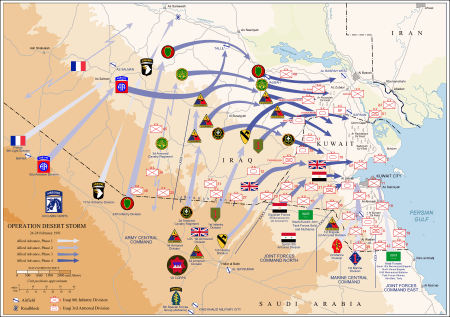

Another crackdown occurred in January and February 1991. Iraqi forces publicly executed suspected members of the Kuwaiti resistance. Kuwaitis were kidnapped, their corpses later deposited in front of their family homes. The bodies of executed Kuwaiti resistance members showed evidence of different kinds of torture, including beating, electrical shocking, and fingernail removal.[44] Some 5,000 Palestinians living in Kuwait were arrested for their activities in support of the resistance, and Palestinian support was enough to cause Iraqi officials to threaten Palestinian leaders. Some Palestinians, however, supported Saddam’s regime because of sympathies with the Ba’ath party’s pugnacious anti-Israel stance. Palestinian members of the resistance sometimes disagreed with resistance tactics such as the boycott of government offices and commercial activity. The Kuwaiti resistance movement was suspicious of this Palestinian ambivalence, and in the weeks after Iraqi forces withdrew, the Kuwaiti government cracked down on Palestinians suspected of sympathizing with the Saddam regime.[51]
Iraqi forces also arrested over two thousand Kuwaitis suspected of helping the resistance and imprisoned them in Iraq. Many of those arrests were made during the Iraqi retreat from Kuwait in February 1991. Hundreds escaped from prisons in southern Iraq after the retreat and over one thousand were repatriated by the Iraqi government,[44] but hundreds remain missing. The fate of 605 Kuwaitis arrested during the occupation remained unknown until 2009, when the remains of 236 of them were identified. Initially, Iraq claimed it had recorded the arrests of only 126 of the 605 missing Kuwaitis.[52] The names of 369 other missing Kuwaitis are stored in files maintained by the International Committee of the Red Cross.[53] Seven of those missing Kuwaitis are women and nearly 24 are under the age of 16. Iraq has made little effort to address the hundreds of missing Kuwaitis, despite trying to mend diplomatic relations with Kuwait in other ways.[52]
The resistance was a grass roots movement and leadership was organized horizontally,[50] although Sheik Salem Sabah was cited as the "nominal head of the resistance movement."[47]
Historical perspective
Yahya F. Al-Sumait, Kuwait’s housing minister, said in October 1990 that the resistance movement helped undermine the occupation’s legitimacy and dispel the idea that Iraq invaded in order to assist with a popular uprising against the Kuwaiti government. The movement also protected Americans, British and other foreigners trapped in Kuwait during the occupation.[47] Some have cited the resistance movement as part of the foundation for a more robust civil society in Kuwait after the occupation.[54][43]
At the Al Qurain Martyrs Museum, Kuwait remembers its citizens slain during the resistance to Iraqi occupation. The families of those martyrs received material benefits from the Kuwaiti government such as cars, homes, and funding for trips to Mecca for the hajj. Since most accounts of the liberation of Kuwait focus on U.S.-led coalition forces, part of Kuwait’s goal in memorializing the resistance is to emphasize Kuwaiti citizens’ role in liberating their own country.[45]
Aftermath
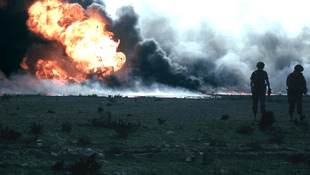
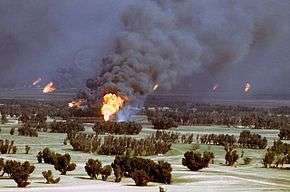
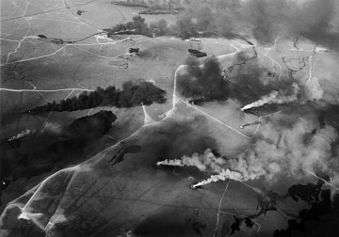
After the Iraqi victory, Saddam Hussein installed Alaa Hussein Ali as the Prime Minister of the "Provisional Government of Free Kuwait" and Ali Hassan al-Majid as the de facto governor of Kuwait.[56] The exiled Kuwaiti royal family and other former government officials began an international campaign to persuade other countries to pressure Iraq to vacate Kuwait. The UN Security Council passed 12 resolutions demanding immediate withdrawal of Iraqi forces from Kuwait, but to no avail.[57]
Following the events of the Iraq–Kuwait war, about half of the Kuwaiti population,[58] including 400,000 Kuwaitis and several thousand foreign nationals, fled the country. The Indian government evacuated over 170,000 overseas Indians by flying almost 488 flights over 59 days.[59]
During the 7-month occupation, the forces of Saddam Hussein looted Kuwait's vast wealth and there were also reports of violations of human rights.[60] A 2005 study revealed that the Iraqi occupation had a long-term adverse impact on the health of the Kuwaiti populace.[61]
International condemnation and Gulf War
After Iraqi forces invaded and annexed Kuwait and Saddam Hussein deposed the Emir of Kuwait, Jaber Al-Sabah, he installed Ali Hassan al-Majid as the new governor of Kuwait.[62]
The Iraqi invasion and occupation of Kuwait was unanimously condemned by all major world powers. Even countries traditionally considered to be close Iraqi allies, such as France and India, called for immediate withdrawal of all Iraqi forces from Kuwait.[63][64] Several countries, including the Soviet Union and China, placed arms embargoes on Iraq.[63] NATO members were particularly critical of the Iraqi occupation of Kuwait and by late 1990, the United States had issued an ultimatum to Iraq to withdraw its forces from Kuwait by 15 January 1991 or face war.[28]
On 3 August 1990, the UN Security Council passed Resolution 660 condemning the Iraqi invasion of Kuwait and demanding that Iraq unconditionally withdraw all forces deployed in Kuwait.[17]
After a series of failed negotiations between major world powers and Iraq, the United States-led coalition forces launched a massive military assault on Iraq and Iraqi forces stationed in Kuwait in mid-January 1991. By 16 January, Allied aircraft were targeting several Iraqi military sites and the Iraqi Air Force was destroyed.[65] Hostilities continued until late February and on 25 February, Kuwait was officially liberated from Iraq.[66] On 15 March 1991, the Emir of Kuwait returned to the country after spending more than 8 months in exile.[67] During the Iraqi occupation, about 1,000 Kuwaiti civilians were killed and more than 300,000 residents fled the country.[68]
Post-Gulf War

In December 2002, Saddam Hussein apologized for the invasion shortly before being deposed in the 2003 invasion of Iraq.[69] Two years later, the Palestinian leadership also apologized for its wartime support of Saddam.[70] In 1990, Yemen's president, Ali Abdullah Saleh, a longtime ally of Saddam Hussein, backed Saddam Hussein's invasion of Kuwait. After Iraq lost the Gulf War, Yemenis were deported en masse from Kuwait by the restored government.
The US military continue a strong presence adding 4,000 troops in February 2015 alone.[71] There is also a very strong US civilian presence with an estimated 18,000 American children in Kuwait being taught by 625 US teachers.[72]
See also
- Operation Desert Storm
- Airlift — A Bollywood film based on the Indian evacuation right after the invasion.[73]
- United Nations Security Council Resolution 660
- Persian Gulf war rationale
References
- Al Moquatel Archived 14 July 2014 at the Wayback Machine
- "1990: Iraq invades Kuwait". BBC On This Day. BBC. 2 August 1990. Retrieved 20 April 2010.
- Johns, Dave (24 January 2006). "1990 The Invasion of Kuwait". Frontline/World. PBS. Retrieved 20 April 2010.
- "Kuwait Organization and Mission of the Forces". Country Studies. Library of Congress. January 1993. Retrieved 20 April 2010.
- "سير العمليات العسكرية للغزو العراقي للكويت", Al Moqatel
- "Kuwaiti casualties". kkackm.
- John Pike. "Iraqi Ground Forces Equipment". Retrieved 19 December 2014.
- Jane's Armour and Artillery 2003–2004
- Armies of the Gulf War, Gordon L. Rottman, 1993, p.48,49
- Tanki v operacii "Shok i trepet", Aleksei Brusilov, Leonid Karyakin, Tankomaster 2003–08(Russian: Танки в операции «Шок и трепет», Алексей Брусилов, Леонид Карякин, Танкомастер 2003–08)
- See the House of Lords case Kuwait Airways Corporation v Iraqi Airways Corporation [2002] UKHL 19.
- "Kuwaiti Casualties". kkamkm.
- "IRAQ: NAVAL THREAT TO US FORCES". Retrieved 19 December 2014.
- المبحث الرابع, إعادة بناء القوات المسلحة لكل من دول مجلس التعاون الخليجي، بعد الحرب, Al Moquatel
- "Archived copy" (PDF). Archived from the original (PDF) on 13 August 2017. Retrieved 1 October 2018.CS1 maint: archived copy as title (link)
- Editors, History com. "Iraq invades Kuwait". HISTORY. Retrieved 9 June 2020.CS1 maint: extra text: authors list (link)
- United Nations Security Council Resolution 660 (Condemning the Invasion of Kuwait by Iraq), S.C. res. 660, 45 U.N. SCOR at 19, U.N. Doc. S/RES/660 (1990) Archived 20 May 2016 at the Wayback Machine. umn.edu. Retrieved on 12 June 2011
- Gause, F. Gregory, III (2005). "The International Politics of the Gulf". In Louise Fawcett (ed.). International Relations of the Middle East. Oxford: The University Press. pp. 263–274. ISBN 0-19-926963-7.
- Cooper, Tom; Sadik, Ahmad (6 August 2007). "Iraqi Invasion of Kuwait; 1990". Air Combat Information Group Journal. Archived from the original on 6 July 2013. Retrieved 27 October 2016.
- "Iran reportedly fires on Kuwaiti island", Lakeland Ledger, 30 March 1988.
- Stork, Joe; Lesch, Ann M. (1990). "Background to the Crisis: Why War?". Middle East Report. 167 (November–December): 11–18. doi:10.2307/3012998. JSTOR 3012998.
- "Iraq strains OPEC consensus", New Strait Times, 8 October 1988
- "OPEC pressures Kuwait to moderate quota demand", New Strait Times, 7 June 1989
- Hindy, Lily (25 January 2008). "Interrogator: Invasion surprised Saddam". The Boston Globe. Associated Press. Retrieved 17 April 2010.
- Hayes, Thomas C. (3 September 1990). "Confrontation in the Gulf; The Oilfield Lying Below the Iraq-Kuwait Dispute". The New York Times.
- Gregory, Derek (2004). The Colonial Present: Afghanistan, Palestine, Iraq. Malden, MA, USA: Blackwell Publishing Ltd. p. 156. ISBN 1-57718-090-9.
- Ibrahim, Youssef M. (26 July 1990). "Iraq Said to Prevail in Oil Dispute With Kuwait and Arab Emirates". The New York Times.
- Friedman, Thomas L. (17 December 1990). "Standoff in the Gulf; A Partial Pullout By Iraq is Feared as Deadline 'Ploy'". The New York Times. Retrieved 17 April 2010.
- "Confrontation in the Gulf" Archived 4 August 2016 at the Wayback Machine, The New York Times, 25 September 1990.
- cable 90BAGHDAD4237, SADDAM'S MESSAGE OF FRIENDSHIP TO PRESIDENT BUSH Archived 7 January 2011 at the Wayback Machine, secret US embassy cable, 25 July 1990, released by WikiLeaks on 1 January 2011
- "Leonard Lopate Show", WNPR, Why Americans Choose War Archived 17 November 2010 at the Wayback Machine 11 November 2010
- "The Iraqi Invasion; In Two Arab Capitals, Gunfire and Fear, Victory and Cheers". The New York Times. Kuwait: Reuters. 3 August 1990.
- Gulf States – Kuwait – Regional and National Security Considerations. Countrystudies.us. Retrieved on 12 June 2011
- Eyewitness, Col. Fred Hart 1 Archived 18 August 2009 at the Wayback Machine. Users.lighthouse.net. Retrieved on 12 June 2011.
- Kenneth M. Pollack, Arabs at war: Military Effectiveness (1948–91), University of Nebraska Press, Lincoln and London, 2002
- FRONTLINE/WORLD. Iraq – Saddam's Road to Hell – A journey into the killing fields. PBS Archived 15 May 2016 at the Wayback Machine. PBS (24 January 2006). Retrieved on 12 June 2011
- "Iran, Israel and the Shi'ite Crescent" (PDF). S. Daniel Abraham Center for Strategic Dialogue. pp. 14–15. Archived from the original (PDF) on 6 November 2014. Retrieved 5 March 2014.
- "Saddam's Security Apparatus During the Invasion of Kuwait and the Kuwaiti Resistance". The Journal of Intelligence History. Winter 2003. pp. 74–75.
- "Two ethnicities, three generations: Phonological variation and change in Kuwait" (PDF). Newcastle University. 2010. Archived from the original (PDF) on 19 October 2013. Retrieved 5 March 2014.
- "The Kuwaiti Resistance". Middle East Forum. March 1995.
- Tyler, Patrick E. "U.S. Said To Be Aiding Kuwaiti Resistance." The New York Times, 31 August 1990, https://www.washingtonpost.com/archive/politics/1990/08/31/us-said-to-be-aiding-kuwaiti-resistance/1fde7859-b358-463d-aace-2928fd0a3ea8/
- Chicago Tribune. "Kuwaiti Resistance Showed Extraordinary Bravery, Cunning Men, Women, Children Who Stayed Behind Helped Foil Iraqi Occupation." The Baltimore Sun, 19 March 1991, http://articles.baltimoresun.com/1991-03-19/news/1991078147_1_kuwait-iraqi-occupation-malik.
- Tétreault, Mary Ann. "Kuwait: The morning after." Current History 91, no. 561 (1992): 6.
- "Iraq and Occupied Kuwait." Human Rights Watch Report, Human Rights Watch, www.hrw.org/reports/1992/WR92/MEW1-02.htm.
- Perry, Tony. "Kuwait Works to Preserve History of Its Resistance to Iraq." Los Angeles Times, 23 February 2003, http://articles.latimes.com/2003/feb/23/world/fg-martyrs23.
- Hedges, Chris. "After The War: Kuwait; At Home Among the Enemy, Kuwaitis Learned to Survive." The New York Times, 5 March 1991, https://www.nytimes.com/1991/03/05/world/after-the-war-kuwait-at-home-among-the-enemy-kuwaitis-learned-to-survive.html.
- Tyler, Patrick E. "Kuwaitis Scale Back Resistance Effort." The Washington Post, 5 October 1990, https://www.washingtonpost.com/archive/politics/1990/10/05/kuwaitis-scale-back-resistance-effort/5f04b295-cb4b-455f-88ef-783191343cea/
- Tyler, Patrick E. "U.S. Said To Be Aiding Kuwaiti Resistance." The Washington Post, 31 August 1990, https://www.washingtonpost.com/archive/politics/1990/08/31/us-said-to-be-aiding-kuwaiti-resistance/1fde7859-b358-463d-aace-2928fd0a3ea8/
- Wheeler, Deborah. "New Media, Globalization and Kuwaiti National Identity." The Middle East Journal (2000): 432–444.
- John M. Levins, "The Kuwaiti Resistance," Middle East Quarterly, accessed 30 April 2018, https://www.meforum.org/articles/other/the-kuwaiti-resistance.
- Mattar, Philip. "The PLO and the Gulf Crisis." Middle East Journal 48, no. 1 (1994): 31–46. https://www.jstor.org/stable/4328660.
- Koring, Paul. "The Missing Kuwaitis of Baghdad’s Gulag." The Globe and Mail, 23 December 2002, updated 17 April 2008, https://www.theglobeandmail.com/news/world/the-missing-kuwaitis-of-baghdads-gulag/article4142930/.
- "Kuwaitis Mourn the Missing in Iraq." BBC News, 14 May 2009, http://news.bbc.co.uk/2/hi/middle_east/8048477.stm.
- Augustus Richard Norton, "The Future of Civil Society in the Middle East," Middle East Journal 47.2 (1993): 205–216.
- Damage Assessment – Kuwait Oil Archived 2 November 2013 at the Wayback Machine. Federation of American Scientists.
- al-Marashi, Ibrahim (9 April 2003). The Significance of the "Death" of Ali Hassan al-Majid. James Martin Center for Nonproliferation Studies.
- Iraq Archived 8 August 2016 at the Wayback Machine. GlobalSecurity.org.
- Kuwait Britannica Archived 11 November 2013 at the Wayback Machine. Britannica.com (19 June 1961). Retrieved on 2011-06-12.
- Rohan Venkataramakrishnan. "The Berlin airlift was remarkable, but the largest civilian evacuation in history is by India". Scroll.in. Retrieved 11 April 2015.
- State of Kuwait Archived 20 May 2016 at the Wayback Machine. Atlapedia.com. Retrieved on 12 June 2011.
- Public health impact of 1990 Iraq invasion of Kuwait Archived 14 December 2009 at the Wayback Machine. Medical News Today. 4 July 2005.
- "CNS – The Significance of the "Death" of Ali Hassan al-Majid". 9 June 2003. Archived from the original on 9 June 2003. Retrieved 28 September 2018.
- "World Acts Against Iraqi Invasion of Kuwait." Archived 21 September 2016 at the Wayback Machine. GlobalSecurity.org.
- Hirst, David; Tisdall, Simon (3 August 1990). "Superpowers unite on Iraq". The Guardian. London.
- Fairhall, David; Walker, Martin (17 January 1991). "Allied planes bomb Iraq: Kuwait's liberation begun, says US". The Guardian. London.
- 25 February 1991: Iraq withdraws from Kuwait Archived 17 August 2016 at the Wayback Machine. Sify Retrieved on 12 June 2011
- Murphy, Kim (15 March 1991). "Emotional Emir Returns to Kuwait Royalty: He covers his face and stoops to kiss the ground. But not many citizens turn out to greet him". The Los Angeles Times. Kuwait City. Retrieved 17 April 2010.
- The Use of Terror during Iraq’s invasion of Kuwait Archived 24 January 2005 at the Wayback Machine. Jafi (15 May 2005). Retrieved on 12 June 2011
- Saddam Sends Apology to Kuwait for Invasion Archived 31 July 2013 at the Wayback Machine. People's Daily. 8 December 2002.
- PLO apologises over Kuwait Archived 2 February 2007 at the Wayback Machine. 12 December 2004.
- "Archived copy". Archived from the original on 30 April 2016. Retrieved 20 September 2016.CS1 maint: archived copy as title (link) UPI.com. 15 February 2015.
- "Archived copy". Archived from the original on 18 September 2016. Retrieved 20 September 2016.CS1 maint: archived copy as title (link) [Arab Times Online]. September 2016.
- Airlift: Akshay Kumar's next a thriller of the biggest human evacuation Archived 11 January 2016 at the Wayback Machine. Times of India. Priya Gupta. 19 August 2014
